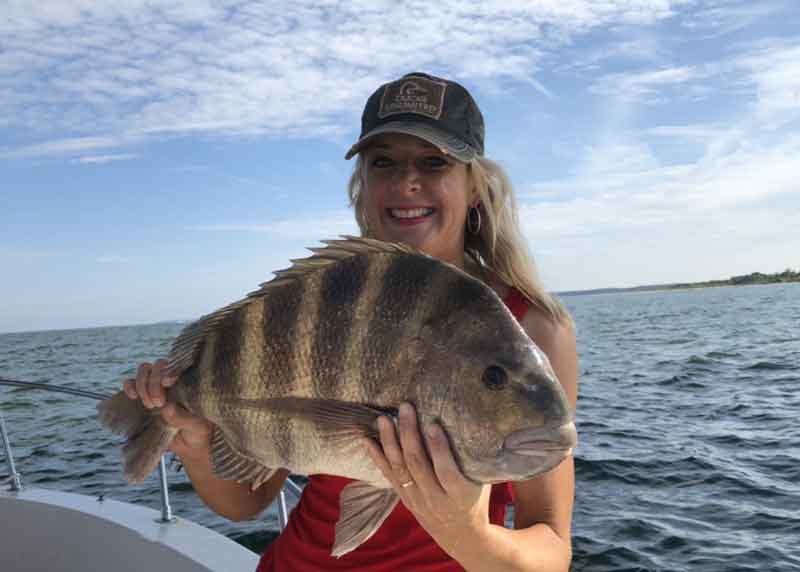Sheepshead are a somewhat common catch in coastal waters along the western Atlantic, as well as providing an unusual summer target for anglers who enjoy Chesapeake Bay Fishing in the Bay’s southern reaches. Sheepshead are a prized fish which put up a good fight to those willing to target them. Not only are sheepshead a popular recreational catch, they are also very tasty and work well in a variety of recipes.

These fish make their way toward the south during the winter months to keep warm, but once early spring hits expect them to come north for spawning season, when sheepshead can be seen hanging around artificial reefs and navigation markers where the water is around 70 degrees Fahrenheit.
Sheepshead Identification
Look for these telltale signs to determine whether you’ve caught a sheepshead:
- Dark, vertical bars across body
- Stubby, human-like rows of teeth
- Compressed body shape
Belonging to the Sparidae family, sheepshead are commonly found along the coast and in bays and estuaries, but they can also tolerate low-salinity brackish waters. On average, a mature sheepshead can grow anywhere from 10 to 20 inches long and reach weights upwards of eight pounds or more. Beginners that reel in this fish should use extreme caution, due to how sharp a sheepshead’s dorsal spines are.
Sheepshead Regulations
Here are links to regulations on a state-by-state basis regarding the season, size, and creel limits for sheepshead:
Record Sheepshead
Robert Martin set the Maryland state record back in 2017, reeling in an 18-pound sheepshead off the South Jetty while fishing the Ocean City Inlet. Delaware’s current record-holder is Dave Walker, who caught a 17-pound two-ounce fish in 2014. Virginia’s state record was set back in 2005 by Arun Nhek. Nhek caught the monstrous 20-pound 12-ounce sheepshead from Seagull Fishing Pier, located directly next to the Chesapeake Bay Bridge Tunnel (CBBT). Click here for more information about fishing at the CBBT.
Best Sheepshead Baits
Here are some recommended baits to use on sheepshead:
- Clams
- Fiddler crabs
- Mussels
- Barnacles
- Shrimp
Best Sheepshead Lures
This section’s title serves as a bit of a misnomer; there are actually no artificials that are recommended for use when fishing for sheepshead. Instead, they mostly prefer the “real” baits that are mentioned above, whether it be alive, fresh, or frozen.
Popular Techniques for Sheepshead Fishing
Bottom fishing is a popular fishing method for sheepshead. Fortunately, no special tackle is required when targeting these fish – a seven-foot medium action spinning rod, paired with a braided line, will work perfectly. Sheepshead are known to bite lightly and steal bait, so the increased sensitivity offered with the braided line is essential. You do want to hide the hook in the bait as securely as possible, as this makes it look more presentable to interested sheepshead and reduces the chance of losing bait. Using the lightest sinker weights possible to get your bait to the bottom will also appear more “natural” to these fish.

Chumming is also a popular way to target sheepshead. When fishing from a boat or pier, fishermen can naturally chum the water by smashing and scraping barnacles into the water from the pilings. Once the bits and pieces are flowing, the angler then drops in his or her line. Every few minutes, scraping off more barnacles helps attract more fish.
Best Places to Fish for Sheepshead
Sheepshead are structure-oriented fish, which means they frequent water where some sort of cover has been constructed. For interested anglers, it is recommended to search near pilings attached to bridges and piers, wrecks, rip-rap, markers, and Chesapeake Bay fishing reefs. Rocks and other naturally-occurring obstructions are popular spots, too. Sheepshead are attracted to these areas for the steady food sources that attach themselves to these structures.
These fish typically steer clear of areas where there is an abundance of algae growth, as it produces phosphorus which transfers into the water. Phosphorus can deplete the amount of available dissolved oxygen in water, and sheepshead in particular show little tolerance against low levels of dissolved oxygen. They also tend to feed more actively while the tide is moving in or out.
Like most fishing outings, searching for sheepshead can be an equally tiresome and rewarding experience. These fish can be extremely temperamental at times, where you are lucky to even get a nibble without losing your entire bait. The thrill of catching this fish and the dinner it provides is one-of-a-kind, however, making the challenge well worth it in the end. Before embarking on your next trip, read our article by Beth Synowiec, pictured above, Catch More Sheepshead” to learn some of the advanced nuances – and more – about sheepshead fishing.
-By Cameron White